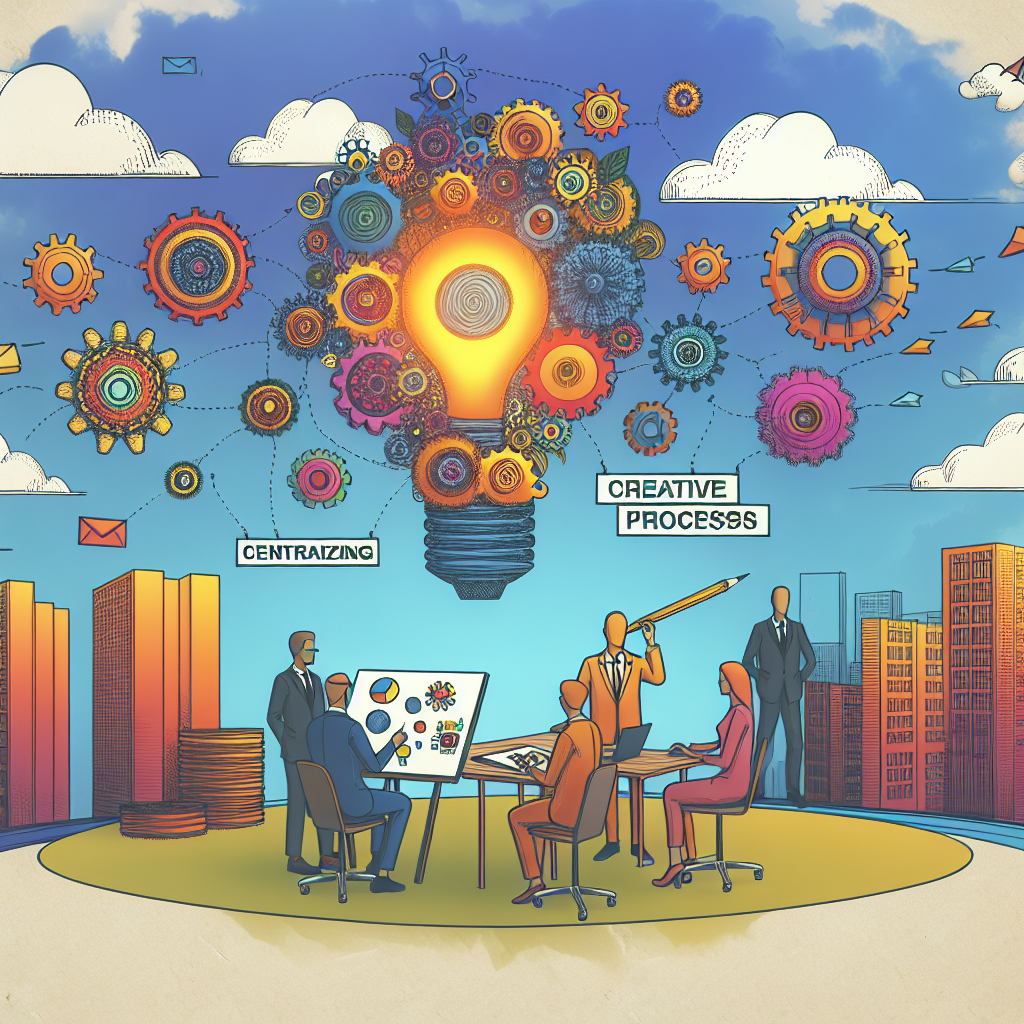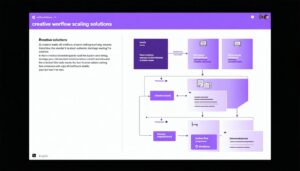Centralizing Content Workflows
Ever thought of centralizing your content workflow? It’s like having a well-oiled machine for your creative crew, keeping everything on track and smooth. Let’s break down why some folks are all for it, and some not so much.
Benefits of Centralization
Bringing your creative game together can be a game-changer. Check out some perks:
| Benefit | Description |
|---|---|
| Efficiency Boost | One stop shop for tasks means less doing the same thing twice. Everything just clicks, nothing gets stuck. |
| Clarity Party | Everyone knows who’s doing what and where. This cuts down on those head-scratching moments and makes getting stuff done together a breeze, as MarkUp.io points out. |
| Save the Bucks | Spending less is always a win. When you combine forces, you cut down on extra jobs and wasted stuff, like Cella Inc. says, especially during big changes like mergers or when teams join up. |
| Rule Stickler | Running tight around what the brand should be and flashing the right customer smile, all thanks to a well-watched process. |
Challenges of Centralization
These perks come with a couple of hurdles that might trip you up if you’re not on your toes:
| Challenge | Description |
|---|---|
| Change Freak-out | Nobody likes being thrown in the deep end, right? People get comfy with what they know. So, changing it all up needs a bit of chit-chat and someone leading the charge. |
| Info Hoarding | If tech tools aren’t in sync, people might end up guarding info like it’s treasure, and that doesn’t help teamwork or getting the job done (Ziflow). |
| Snail-Paced Decisions | Sometimes, with all the organizing, decisions need to get a stamp from the big bosses, and that takes time. Tick-tock goes the clock, and you’re still waiting for the green light (The Decision Lab). |
With your eyes open to both sides of the coin, you can decide if putting everything under one roof is the way to go for you. Need more advice on how to keep your content gears turning smoothly? Check out content creation tips and workflow software that gets those creative juices flowing.
Enhancing Creative Collaboration
Getting the squad together on the same creative page leads to top-notch stuff. Syncing up dreams, setting clear paths, and chatting openly jazzes up your team’s mojo.
Importance of Vision Alignment
Before you kick off any group gig, getting everyone dreaming in the same way is gold. This harmony in thoughts gives the work its vibe and jazzes up the team. Without this shared groove, it’s easy to end up with ‘meh’ results and clients who aren’t exactly doing a happy dance.
Being on the same wavelength helps pull the crew together and lights a fire under them. Toss regular brainstorming pow-wows into the mix where folks can swap brainwaves and make everyone feel like they’re on the team.
Defining Clear Processes
Laying down the law on how you cook, serve, and OK your content keeps the wheels turning without a hitch. If your crew’s kind of winging it, chaos reigns, and all that admin jazz will side-track the real fun.
Here’s a peak at a typical content creation jam session:
| Stage | Description |
|---|---|
| Ideation | Cook up ideas while tossing stuff around |
| Development | Put pen to paper and create the magic |
| Review | Team pow-wow to let fresh eyes give input |
| Approval | Thumbs up from the big cheeses |
| Distribution | Getting the word out far and wide |
With the pathway all mapped out, your band’s got the rhythm they need to improvise like pros.
Effective Communication Strategies
Talk the talk to keep your collabs sizzling, in-person or online. With a clear way to yak, straying off the path is less of a worry. Missteps can rain on the parade, making a set way of chatting a must.
Tech tools for yarn spinning like creative team collaboration tools smooth out the tweaks and iron out any crossed wires. Platforms with real-time edits and chat leave zero questions when tweaking till it shines.
Getting everyone in tune through shared visions, step-by-step plans, and solid communication tunes up your teamwork. Check out ways to slip these tricks into your gigs and see the magic of a mixed creative vibe. For more wisdom nuggets, peep centralizing content workflows and optimizing creative team productivity.
Optimizing Communication Channels
You’ve got a creative team and you want them to rock n’ roll, right? Smooth communication is like the secret sauce. Keeping it all tidy helps everyone get along and smash those deadlines.
Centralizing Communication
First things first, all these chat apps and email threads can make your head spin. Text flying around like crazy can mean important stuff gets lost. So, set some ground rules for when to email, when to message, and when to huddle in the virtual meeting room. Doing this keeps everyone in the loop and nothing slips away unseen.
Get yourself some cool review and approval tools that everyone uses. That way, feedback isn’t scattered all over and there’s way less chance of someone missing the memo. Want more tips on keeping your creative gang talking? Check out our section on enhancing creative team communication.
| Communication Style | When to Use It |
|---|---|
| For big announcements or documentation | |
| Instant Messaging | Chat about stuff on the go |
| Project Management Tools | Keep tabs on tasks and progress |
| Reviewing Platforms | For feedback and sign-offs |
Preventing Information Silos
Ever played the game of ‘who knows what’? That’s what happens if one team’s chatting but no one else knows about it. Wasting time searching for info feels like looking for a needle in a haystack, right? Keep a stash of essential docs where everyone can get them, no running around needed.
Invest in some tech that talks to different departments and hold meet-ups where everyone swaps info. Makes for a nice culture where sharing is caring. Look at our guides on content creation workflow analysis and content workflow software for even more handy tips.
Getting your team talking and keeping them in the know sets them up for success. Better teamwork equals awesome results.
Centralization Strategies
Shifting your creative tasks into one central process can make everything run smoother and just boost your efficiency overall. But, hey, making this leap ain’t as simple as flipping a switch. No worries! I’m going to give you the lowdown on getting this done right.
Adoption and Implementation
Getting on board with a central creative system starts with you having a clear picture of where you want to go. This vision shows how bringing things together fits right in with your overall game plan. Kick things off by giving your current setup a once-over and pinpointing where a centralized approach could really save the day.
Here’s how to get started:
-
Know What You Need: Get your team together and see what’s working and what’s driving them nuts in your current setup.
-
Pick the Right Tools: Go shopping for some solid content workflow software that helps keep the team talking and on the same wave.
-
Map It Out: Lay down a step-by-step plan with goals and who’s in charge of what.
| Step | Action |
|---|---|
| 1 | Pinpoint needs and gripes |
| 2 | Choose reliable tools |
| 3 | Draft a step-by-step implementation plan |
Overcoming Resistance to Change
Let’s be real—people usually hate change, especially when it affects how they work. It’s like dreading a jump into chilly water. But you can ease the fear by keeping everyone in the loop and open to feedback.
- Get Them Involved: Let the team have their say in the planning to feel they’re part of making it work.
- Spell Out the Perks: Lay out what’s in for them—like getting work done faster and better (Corporate Finance Institute).
- Train Like Pros: Give them the goods on how to use these new tools with some rock-solid training.
Solutions for Successful Centralization
To make sure your centralization dream isn’t just daydreaming, focus on these:
-
Lay Down Clear Rules: Set up a standard way of getting, checking, and approving content. This keeps things neat and transparent for everyone.
-
Bring the Team Together: Use creative team collaboration tools to keep everyone chatting and on the same page, so nobody’s left out in the dark.
-
Keep Reviewing: Regular check-ins to see how the system’s holding up. This lets you tweak stuff to make sure you’re always on top of your game.
Follow these steps, and not only will your centralized processes click into place, but they’ll also create a more unified and efficient crew. Dive deeper into our content creation best practices and content process optimizations for more tips.
Centralization vs. Decentralization
Understanding Centralization
Centralization is basically putting the decision-making power in the hands of a few top dogs—usually the folks with the big titles like CEO or President. These folks call the shots and steer the company ship (The Decision Lab). It’s like having a GPS guiding every turn; the directions are clear, and everyone knows who’s at the wheel.
But if these leaders get bogged down, it’s like driving in a traffic jam—you’re not getting anywhere fast. Striking that tricky balance between central power and flexibility is what keeps the engine running smoothly.
Balancing Decision-Making Structures
Taking a look at decentralization, it’s all about spreading out the decision-making love. Authority trickles down through the ranks, empowering managers and team members to chip in with their ideas and make decisions. Decisions often get shaped at the ground level before rising to the higher-ups for the big final handshake (The Decision Lab). This can lead to a crew that’s a bit like a jazz band—more freedom that sparks creativity and quick responses to changes.
Companies aren’t just one or the other. They exist on a spectrum, where both democratic and authoritarian styles get blended depending on needs (The Decision Lab). For your team, finding that sweet spot can be the key to getting work done efficiently while keeping things fresh and collaborative.
Here’s a quick cheat sheet:
| Structure Type | Pros | Cons |
|---|---|---|
| Centralization | Fast decisions, clear roles | Chokes creativity, risks jams |
| Decentralization | Fresh ideas, more wiggle room | Possible mixed signals, slower moves |
Crave more wisdom on boosting your team’s magic? Check out our takes on content creation tips and organizing workflows.

